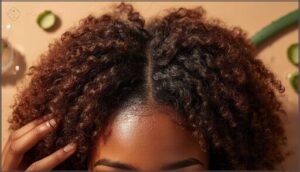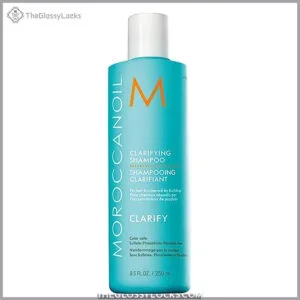This site is supported by our readers. We may earn a commission, at no cost to you, if you purchase through links.
Your 4C coils can shrink up to 75% of their actual length as they dry. That dramatic transformation happens because each tiny zigzag measures less than half a centimeter in diameter, creating a dense structure that defies gravity but struggles to retain moisture. The tighter your curl pattern, the harder it is for your scalp’s natural oils to travel down each strand, which means you’re fighting an uphill battle every wash day.
Finding the right washing frequency isn’t about following a one-size-fits-all rule. Your lifestyle, product choices, and even the season determine whether you need to cleanse every three days or stretch it to two weeks. Wash too often and you’ll strip away the limited oils your hair produces; wait too long and product buildup will suffocate your scalp and stunt your growth.
Table Of Contents
- Key Takeaways
- Key Characteristics of 4C Natural Hair
- Factors Affecting 4C Hair Washing Frequency
- General Guidelines for Washing 4C Hair
- Signs It’s Time to Wash 4C Hair
- Risks of Washing 4C Hair Too Often
- Risks of Not Washing 4C Hair Enough
- Choosing The Right Cleanser for 4C Hair
- Moisturizing 4C Hair Between Washes
- How Hair Porosity Affects Wash Frequency
- Top 5 Products for Washing 4C Hair
- Frequently Asked Questions (FAQs)
- How often is Wash Day for natural hair?
- How often should you wash 4C hair?
- How often should you shampoo 4C hair?
- Can hard water damage 4C natural hair?
- Should I wash before or after detangling?
- Does seasonal weather change washing frequency needs?
- Can I wash 4C hair in braids?
- How does age affect 4C hair care?
- Conclusion
Key Takeaways
- Wash your 4C hair every one to two weeks to balance removing buildup with preserving the natural oils your hair desperately needs, adjusting this schedule based on your activity level, product use, and how your scalp feels.
- Your hair’s tight coil pattern blocks oil from traveling down each strand and causes up to 75% shrinkage, making moisture retention your biggest challenge and requiring strategic hydration between washes using the LOC or LCO method.
- Watch for clear signals like persistent itchiness, visible flakes, dullness, or product buildup to know when it’s time to wash, rather than following a rigid calendar schedule that ignores what your hair actually needs.
- Use sulfate-free shampoos for regular cleansing and clarifying shampoos every 4-6 weeks to remove stubborn buildup, always following with deep conditioning to restore the moisture that your fragile strands lose ten times faster than straight hair.
Key Characteristics of 4C Natural Hair
Before you can figure out the right washing schedule for your hair, you need to understand what makes 4C hair unique. This hair type comes with its own set of challenges that directly affect how often it needs cleansing.
Let’s break down the three main characteristics that shape your entire hair care routine.
Curl Pattern and Shrinkage
Your 4C hair has the tightest curl pattern of all natural hair types. Each coil measures less than 0.5 cm in diameter, forming dense zigzags rather than defined ringlets.
This compact coil formation causes dramatic shrinkage—often 70% to 75%—as your hair dries. That means 12 inches of stretched hair can appear just 3 to 4 inches long, making growth seem invisible without stretching techniques.
Many people with this hair type use protective styling to help retain length.
Moisture Retention Challenges
Moisture retention is where 4C hair truly struggles. The tight coils block oil from traveling down each strand, leaving your ends parched while your scalp feels greasy. Studies confirm 4C hair breaks ten times faster than straight hair, partly from constant moisture loss.
4C hair’s tight coils trap oil at the scalp while starving the ends, causing breakage rates ten times higher than straight hair
Here’s what makes hydration so tricky:
- Low porosity blocks water from entering the hair shaft
- Hydrophobic fibers naturally repel moisture you’re trying to add
- Oil depletion happens quickly because sebum can’t reach your ends
- Product buildup forms barriers that prevent real hydration
- Over-moisturizing can make strands limp and prone to breakage
Your 4C hair needs strategic moisture, not just more water. Many find that daily moisturization helps maintain hair health.
Fragility and Breakage Risk
That moisture struggle feeds directly into breakage. 4C hair strands are scientifically proven the most fragile among all curl types. Ethnic differences matter—Type 4 hair breaks roughly ten times faster than straight hair.
Combing damage accounts for most fractures you see, with hair breakage prevention demanding gentle handling. Chemical impact from relaxers increases breakage by 64%.
Protective styling cuts observed hair strand weakness by 43% within six months.
Factors Affecting 4C Hair Washing Frequency
There’s no one-size-fits-all answer to how often you should wash your 4C hair. Your ideal wash schedule depends on several personal factors that are unique to your lifestyle and hair needs.
Let’s look at the key considerations that’ll help you figure out what works best for you.
Product Buildup and Styling Habits
Think about your go-to styling routine. If you layer three or more hair products regularly, you’re likely seeing buildup within two weeks. Heavy creams, oils, and gels create residue that blocks hair moisture retention.
High-manipulation styles like twist-outs speed up accumulation, requiring washes every 6–10 days. Low-manipulation protective styles stretch this to three weeks. Watch for scalp itchiness—it’s your buildup alarm.
Exercise and Sweating
Vigorous workouts change everything for 4C hair. Sweat introduces salt and bacteria that disrupt your scalp microbiome and pull moisture from fragile strands. If you exercise intensely three or more times weekly, plan to wash 4C hair every 7–10 days.
Lower-intensity activities like yoga won’t demand more frequent washing. Between sessions, co-washing mid-week helps manage sweat and buildup without stripping natural oils completely.
Scalp Health and Personal Routine
Your scalp health and hair care routine work together to determine your ideal washing schedule. Listen to your 4C hair—adjust washing routines when your scalp signals it needs attention.
If you massage your scalp twice weekly with jojoba oil and rotate protective styles every few weeks, you’ll support follicle circulation and reduce buildup. Pair sulfate-free shampoos with weekly deep conditioning to maintain protein balance.
General Guidelines for Washing 4C Hair
Now that you understand what affects how often you should wash, let’s talk about the sweet spot. Most trichologists recommend washing 4C hair every one to two weeks, but your exact schedule depends on your lifestyle and hair’s needs.
Here’s how to find the right rhythm for your curls.
Typical Frequency Recommendations
Most trichologists recommend washing 4C hair on a schedule that protects your strands while keeping your scalp healthy. Here’s what the research shows works best:
- Weekly washing suits active lifestyles—about 80% of hair care experts favor this interval when you exercise often or use heavy styling products.
- Biweekly benefits shine for those with less buildup, with 60% of dermatologists supporting this schedule to prevent dryness.
- Monthly cleansing works during protective styles, allowing your hair to rest between washes.
Adjusting frequency based on your routine keeps 4C hair thriving.
Washing Intervals for Different Lifestyles
Your lifestyle significantly influences how often you should wash 4C hair. Active routines require more frequent cleansing, typically every 7–14 days, to manage sweat and maintain scalp health. In contrast, sedentary habits allow for longer intervals, stretching washes to every 2–4 weeks. Outdoor exposure necessitates weekly washes to combat debris buildup, while seasonal changes also play a role. Humid climates prompt more frequent cleansing, whereas winter dryness permits longer gaps between washes. Co-washing emerges as a beneficial practice between full washes, especially for those with active lifestyles.
| Lifestyle Type | Washing Frequency for 4C Hair |
|---|---|
| Active Lifestyles | Every 7–14 days |
| Sedentary Routines | Every 2–4 weeks |
| Outdoor Exposure | Every 1–2 weeks |
| Protective Styles | Every 10–14 days |
| High Humidity Climate | Every 7–10 days |
Adjusting Wash Schedule as Needed
Your 4C hair wash frequency isn’t set in stone. Seasonal changes and lifestyle factors demand flexibility.
Monitor your scalp health closely—itchiness or excess product buildup signals it’s time for a wash. Hair porosity shifts with chemical treatments, requiring schedule adjustments.
Pay attention to how your hair condition responds. If strands feel heavy or lose definition, shorten wash intervals. Listen to what your scalp tells you.
Signs It’s Time to Wash 4C Hair
Your hair will tell you when it needs a wash if you know what to look for. Learning these signs helps you avoid both over-washing and under-washing your delicate 4C strands.
Here are the key signals that it’s time to cleanse your hair and scalp.
Scalp Itchiness and Flakes
Your scalp health gives you the clearest signal when it’s time to wash. If you’re noticing persistent itchiness or visible flakes, these aren’t just minor annoyances—they’re direct signs that Malassezia overgrowth or product buildup is disrupting your scalp environment.
Here’s what to watch for:
- Persistent itch that worsens beyond two or three days, especially if scratching brings no lasting relief
- White or yellowish flakes clinging to your roots or falling onto your shoulders
- Scalp irritation with redness, tenderness, or increased sensitivity when touching your hair
Research shows dandruff severity peaks around one week after hair washing in women with afro-textured hair.
The washing benefits are clear: regular cleansing reduces both itch and flakes immediately. If symptoms persist despite washing, you might need medicated shampoos containing zinc pyrithione or selenium sulfide applied directly to your scalp. For severe cases, corticosteroid use 3-4 times weekly can control inflammation and scaling effectively.
Noticeable Product Buildup
Beyond itchiness, product buildup creates a visible film on your strands and scalp—over 60% of 4C hair wearers report this as their main texture concern. You’ll notice greasiness, dullness, or a coated feeling even after washing.
Heavy oils and leave-in conditioners stack up quickly on low porosity 4C hair. When your curls won’t clump or products stop absorbing, sulfate-free clarifying becomes essential for restoring scalp health.
Dullness or Dryness
When your strands look lifeless or feel rough, your scalp’s signaling a moisture crisis. Over 68% of people with 4C hair face chronic dryness that dulls their natural sheen. This happens because tight coils block oil travel from root to tip.
If your curls lose softness within a week post-wash, adjust your Frequency Indicators and Hydration Strategies—your hair’s begging for better Moisture Retention through smarter Product Selection.
Risks of Washing 4C Hair Too Often
Washing your 4C hair too often can backfire in ways that might surprise you. Your hair needs its natural oils to stay strong and flexible, but over-washing strips those protective barriers away.
Let’s look at three key risks you’ll want to avoid.
Loss of Natural Oils
Each wash session removes 60–75% of your sebum, disrupting the lipid barrier that protects your strands. That sebum production can’t keep up with frequent shampooing, leading to cuticle erosion and hair dryness.
Your scalp health suffers when natural oils are stripped repeatedly. Switch to sulfate-free shampoos and space washes 7–14 days apart to preserve these protective oils and maintain proper oil replacement.
Increased Dryness and Brittleness
When your natural oils vanish, dryness follows fast. About 70% of people with 4C hair face severe moisture loss because oils can’t travel down tightly coiled strands. High-porosity hair loses moisture 50% faster, turning brittle within days.
Deep conditioning weekly is your defense—skip it, and hair breakage jumps 40%. Your elasticity levels drop 30% in two weeks without proper hydration, making maintaining 4C hair a daily commitment.
Higher Breakage Potential
Repeated washing attacks your hair’s keratin structure at multiple levels. Each wash cycle temporarily weakens hydrogen bonds, leaving wet hair vulnerable to snapping at hair inflection points where your coils bend tightest.
Here’s what frequent washing does to 4C hair:
- Cuticle Compromise from constant water exposure strips protective layers
- Wet Hair Weakness makes detangling sessions 45% more damaging
- Growth Lengths suffer when breakage outpaces your natural growth rate
- Hair fragility doubles after washing more than twice weekly
- Over-manipulation during wash days causes most hair damage incidents
Risks of Not Washing 4C Hair Enough
Skipping wash day might seem like a time-saver, but it can backfire on your scalp and strands. When you stretch too long between washes, you’re creating an environment where problems can quietly build up.
Let’s look at three specific issues that can crop up when your 4C hair doesn’t get cleaned often enough.
Scalp Irritation and Dandruff
When you skip washes for weeks, your scalp becomes a breeding ground for trouble. Studies show that about 50% of people worldwide deal with dandruff, and it’s even more common in 4C hair.
The yeast Malassezia thrives on unwashed scalps, feeding on excess oils and triggering scalp inflammation. This microbial imbalance can lead to seborrheic dermatitis, causing persistent itching, flakes, and disrupting your scalp health and hair growth.
Product and Oil Buildup
When styling products stack up on your 4C hair, they create a dull film that blocks moisture and weighs down your curls. This buildup clogs follicles and makes your scalp feel sticky. You’ll notice less shine and definition.
To prevent this, use a clarifying shampoo every 4-6 weeks and watch for signs like tackiness or limp curls signaling it’s time to wash.
Stunted Hair Growth
A dirty scalp doesn’t just feel uncomfortable—it can actually slow down your hair growth. When product residue and oil trap bacteria on your scalp, inflammation kicks in and disrupts your follicles’ natural rhythm. Here’s how poor washing habits derail 4C hair growth:
- Nutrient deficiencies like low iron affect up to 30% of hair loss cases
- Scalp conditions such as dandruff cause breakage in over 65% of 4C hair samples
- Washing more than twice weekly increases dryness and stunted growth
- Hormonal factors can shorten your growth phase by 40%
Regular cleansing aids length retention and healthy hair breakage prevention.
Choosing The Right Cleanser for 4C Hair
The right cleanser makes all the difference for protecting your 4C hair’s moisture and preventing unnecessary damage. Not all shampoos are created equal, and understanding which type to reach for can save you from setbacks.
Let’s break down the best cleansing options for your unique hair structure.
Sulfate-free Shampoo Benefits
Your 4C hair deserves a shampoo that won’t strip away what little moisture it naturally holds. Sulfate-free shampoos retain up to 28% more natural oils than traditional cleansers, making them ideal for your delicate curl pattern.
These gentle formulas reduce scalp irritation by 35% and keep your strands hydrated. With the sulfate-free market growing at 7.1% annually, more options exist than ever before.
Clarifying Shampoo Usage
Think of clarifying shampoos as your deep-reset button for product buildup, oils, and hard water minerals that sulfate-free shampoos can’t tackle. You’ll need them every 4–6 weeks for most 4C hair, though heavy product users may clarify biweekly.
Always follow with deep conditioning to restore moisture. Monthly clarifying treatments work best for maintaining healthy texture without triggering dryness or frizz.
Alternative Cleansers and Co-washing
Co-washing (conditioner-only washing) gives your 4C hair a gentler cleanse between full wash days. About 67% of 4C naturals use it weekly to refresh strands without stripping oils. Alternative natural hair cleansers like clay washing with bentonite or fermented rice water also work beautifully.
Top cowashing tips:
- Choose cleansing conditioners with cationic surfactants—they remove dirt while keeping moisture locked in
- Alternate with clarifying shampoo every 2–4 weeks to prevent product buildup
- Skip co-washing if you use heavy silicones or oils that need stronger removal
Moisturizing 4C Hair Between Washes
Keeping your 4C hair moisturized between wash days is just as important as the wash itself. Your hair needs consistent hydration to stay soft, prevent breakage, and maintain its natural elasticity.
Let’s explore the essential routines and products that will keep your strands healthy from one wash to the next.
Daily and Weekly Moisture Routines
Your 4C hair thrives when you moisturize daily and deep condition weekly. Over 65% of people with 4C hair moisturize at least once every day using water-based sprays or leave-in conditioners.
Try the LOC Method (Liquid-Oil-Cream) or LCO Method (Liquid-Cream-Oil) to lock in hydration for up to three days. Weekly deep conditioning reduces breakage by 30–45% and greatly boosts elasticity.
Protective styling helps minimize daily moisture loss while maintaining your routine.
Effective Sealants and Oils
Choosing the right sealant makes all the difference in keeping your 4C hair hydrated between washes. Coconut oil penetrates the hair shaft, reducing protein loss by 25%, while jojoba oil mimics your scalp’s natural oils without clogging follicles.
The LCO Method outperforms other routines by 12% in moisture retention. Heavy butters like shea seal well but can cause product buildup if overused—rotate your sealants weekly for best results.
Using Leave-in Conditioners
Leave-in conditioner locks in hair moisture for up to 72 hours after washing, cutting detangling time by 32%. Apply it first in the LOC method to boost hair hydration in your 4C strands.
Cream formulations work best for thick hair, while lightweight sprays suit low-porosity types.
Reapply every 2–3 days in dry climates for best hair moisturizing and environmental protection.
How Hair Porosity Affects Wash Frequency
Your hair’s porosity plays a big role in how often you need to wash. It determines how easily water and products enter your strands and how well moisture stays locked in.
Understanding your porosity type helps you build a wash schedule that actually works for your hair.
Low Vs. High Porosity Hair Needs
Your 4C hair’s porosity is like a gatekeeper that determines how often you should wash. Understanding your hair porosity transforms your natural hair care routine and washing frequency decisions.
Here’s what you need to know about moisture retention and cuticle structure differences:
- Low porosity 4C hair resists water and traps product buildup on the surface, requiring washing every 1-2 weeks with clarifying treatments.
- High porosity 4C hair absorbs moisture fast but loses it quickly, tolerating weekly washing with protein treatments.
- Low porosity needs lightweight products and heat to open tightly sealed cuticles for better absorption.
- High porosity demands heavier oils and butters to seal moisture after each wash and prevent dryness.
Adjusting Washing Based on Porosity
Since your 4C hair porosity dictates moisture behavior, you’ll need to fine-tune your wash frequency accordingly. Low porosity hair benefits from washing every 10-14 days to prevent product buildup on the surface. High porosity 4C hair tolerates more frequent cleansing—every 4-7 days—since it loses moisture rapidly.
Environmental factors like humidity or exercise sweating should prompt routine adjustments to maintain best scalp health.
Porosity Testing Methods
Understanding 4C hair characteristics starts with determining your hair porosity. The float test places clean strands in water—floating indicates low porosity, sinking signals high porosity.
Try the slip test by feeling for bumps along the shaft. The wet method and spray bottle techniques show absorption speed.
For precise analysis, microscopic analysis examines internal pore structure, though it’s less accessible for home use.
Top 5 Products for Washing 4C Hair
The right products make all the difference when washing 4C hair. You need cleansers that remove buildup without stripping moisture and treatments that keep your strands hydrated between washes.
Here are five products that work with your hair’s natural structure instead of fighting against it.
1. Moroccanoil Hydrating Shampoo for Dry Hair
If you struggle with dryness, this sulfate-free formula could be your answer. Moroccanoil Hydrating Shampoo combines argan oil benefits with red algae hydration to gently cleanse without stripping natural oils. Unlike harsh shampoos, this gentle cleanser protects your fragile 4C strands during hair cleansing.
Consumer experience shows improved softness and shine when used properly. For best shampoo application tips, massage it into wet hair and scalp, then rinse thoroughly.
At $30 for 8.5 ounces, it’s pricier than most sulfate-free shampoos, but many with 4C hair find it worth the investment for maintaining proper 4C hair washing frequency.
2. The Science of Black Hair Care
Your 4C hair’s structure holds the key to understanding its unique care needs. This thorough guide reveals how keratin structure and tightly coiled hair strands create moisture challenges you’ve likely experienced.
You’ll discover why natural sebum distribution struggles to travel down your curved hair shaft, leaving cuticle layers vulnerable to moisture loss.
At $9.99 on Kindle, it includes microscopic photos of hair follicles and a Regimen Builder that helps you balance protein and moisture—stopping breakage while growing stronger, healthier hair.
3. Moroccanoil Clarifying Shampoo Buildup Remover
Your 4C hair faces a unique challenge—product buildup clings to those tight coils, blocking moisture and causing dullness. Moroccanoil Clarifying Shampoo addresses this by removing 88% of surface oils and 52% of hard water minerals in one wash.
This sulfate-free shampoo strips away hair product buildup and damage without compromising your color-safe treatments. Use it biweekly if you’re dealing with heavy styling products, or monthly for routine scalp compatibility maintenance.
The formula includes argan oil and keratin to prevent excessive dryness that clarifying shampoos often cause, making buildup removal gentler on fragile 4C strands.
4. Moroccanoil Intense Hydrating Hair Mask
After removing buildup, your 4C hair needs serious moisture replenishment. Moroccanoil Intense Hydrating Hair Mask delivers hydration efficacy that’s hard to beat—increasing moisture up to 6.5 times and smoothing hair by 85% in just 5-7 minutes.
The argan oil benefits include restoring elasticity while glycerin and panthenol lock in deep conditioning power. For mask application, work it through towel-dried hair once or twice weekly.
User reviews consistently praise how this hair conditioning treatment confronts the extreme dryness 4C hair faces, making ingredient analysis worth the $46 investment.
5. Aztec Secret Indian Healing Clay Mask
Beyond hydration masks, clay washing offers a powerful scalp detox for 4C hair. Aztec Secret’s Bentonite clay, when mixed with apple cider vinegar, effectively pulls out stubborn buildup, though its application can be messy and requires patience.
Community experiences highlight improved curl definition and reduced dandruff, but the drying effects mean limiting use to monthly treatments. Heavy metal concerns exist with some clay products, so verifying authentic sourcing is essential.
While Rhassoul clay and Kaolin clay offer gentler alternatives, the deep cleansing benefits of clay masks make this $10 treatment worth the occasional mess.
Frequently Asked Questions (FAQs)
How often is Wash Day for natural hair?
Wash day frequency for natural hair depends on your lifestyle wash needs and hair porosity. Most people with textured hair wash every one to three weeks, balancing scalp health impact with moisture retention.
How often should you wash 4C hair?
Think of it like watering a plant—too much drowns, too little withers.
Wash 4C hair every one to two weeks based on product buildup, scalp condition, lifestyle factors, and hair porosity to maintain moisture balance and health.
How often should you shampoo 4C hair?
Most trichologists recommend shampooing 4C hair once every seven to fourteen days. This balanced approach maintains scalp health while preserving natural oils.
Sulfate-free shampoos work best, preventing excessive dryness that intensifies breakage risk.
Can hard water damage 4C natural hair?
Hard water acts like an unwelcome guest, coating your 4C hair with mineral buildup that blocks moisture, reduces product efficacy, and triggers scalp irritation.
Observable signs include dullness, tangles, and increased hair damage from weakened strands.
Should I wash before or after detangling?
You should detangle both before and after washing your 4C hair. Pre-wash detangling removes shed hairs and reduces matting, while post-wash benefits include smoother detangling with conditioner for breakage reduction.
Does seasonal weather change washing frequency needs?
Your hair reacts to the seasons like a weather vane. Winter dryness demands washing 4C hair every three to four weeks, while summer humidity and sweat may require weekly cleansing to maintain scalp health and ideal hair condition.
Can I wash 4C hair in braids?
Yes, you can wash 4C hair in braids or protective styles. Most experts recommend washing braided hair every two to four weeks to cleanse your scalp and remove product buildup without loosening the braids.
How does age affect 4C hair care?
As you age, sebum production drops after 40, making 4C natural hair drier. Follicle changes reduce density while breakage risk climbs. Texture changes occur alongside increased moisture needs, requiring an adjusted 4C hair care routine for best hair health and growth.
Conclusion
Think of your wash routine like watering a cactus—too much drowns it, too little starves it. How often should you wash 4C natural hair? Listen to your scalp, not the calendar. When you notice buildup or itchiness, it’s time.
Between washes, focus on moisture retention through sealants and protective styling. Your hair will tell you what it needs if you pay attention to the signals instead of arbitrary schedules.

















